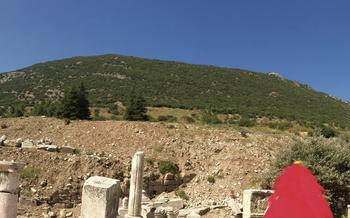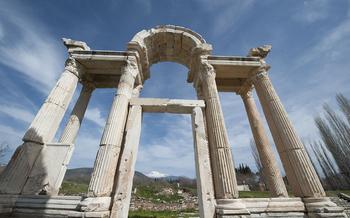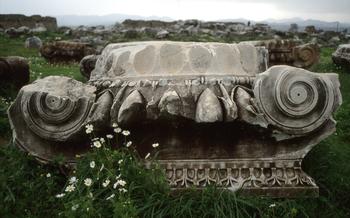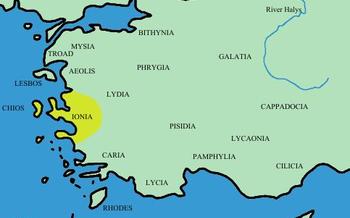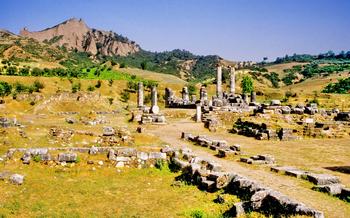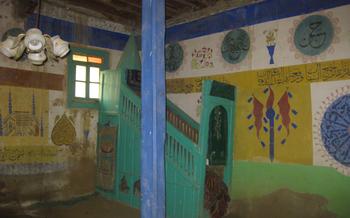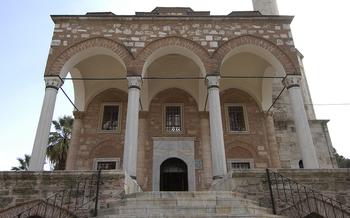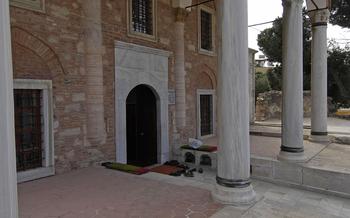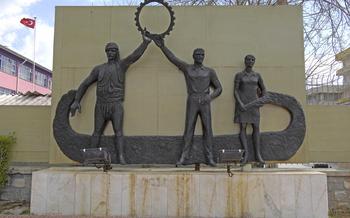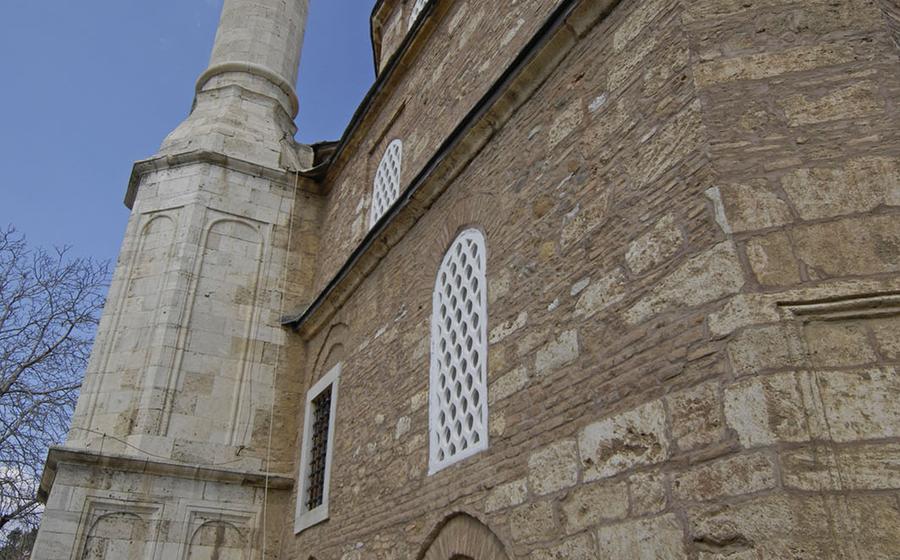
Kadıkalesi Anaia Excavations
- Kadıkalesi Anaia Excavations: A Journey Through History
- Historical Background
- Archaeological Discoveries
- Cultural Heritage
- Historical Significance
- Exploring the Archaeological Ruins
- Unlocking the Secrets of the Artifacts
- Connecting with Kadıkalesi Anaia's Natural Beauty
- Delving into the Historical Context
- Unveiling the Archaeological Process at Kadıkalesi Anaia
- Appreciating the Site's Architectural Marvels
- Engaging with the Local Culture
- Planning Your Visit
- Respecting the Site's Heritage
- Enhancing Your Experience
- Insider Tip: Unveiling the Hidden Gem of Kadıkalesi Anaia
Kadıkalesi Anaia Excavations: A Journey Through History
Journey back in time to the ancient city of Anaia, nestled in the heart of Turkey's Aydın province. Discover the fascinating story of this once-thriving metropolis, dating back to the Hellenistic period. As you explore the Kadıkalesi Anaia site, you'll embark on an archaeological adventure, uncovering the secrets of a civilization that played a pivotal role in the region's history.
The excavations at Kadıkalesi Anaia have yielded a wealth of archaeological treasures, including well-preserved city walls, temples, residential areas, and public buildings. These ruins offer a glimpse into the daily lives of Anaia's inhabitants, their religious practices, and their architectural achievements. The site also holds cultural and religious significance, with evidence of worship dedicated to the goddess Artemis, whose temple once stood as a symbol of her divine presence.
Historical Background
Anaia's history is intertwined with that of the ancient Greek city of Miletus. Founded in the 4th century BC, Anaia served as an important port and trading center, connecting the Aegean Sea with the Anatolian hinterland. Its strategic location made it a hub of cultural exchange and commerce, attracting people from various regions of the Mediterranean.
Archaeological Discoveries
The archaeological excavations at Kadıkalesi Anaia began in the late 19th century and have continued to this day. Over the years, archaeologists have unearthed a treasure trove of artifacts, including pottery, ceramics, sculptures, jewelry, and inscriptions. These discoveries have shed light on the artistic traditions, religious beliefs, and economic activities of Anaia's inhabitants.
Cultural Heritage
Anaia's cultural heritage is deeply rooted in ancient Greek mythology. The city was dedicated to the goddess Artemis, who was worshipped as the protector of the city and its people. The Temple of Artemis, one of the most prominent structures at the site, served as a religious center where rituals and offerings were made to honor the goddess.
Historical Significance
The Kadıkalesi Anaia excavations have played a crucial role in understanding the development of ancient civilizations in Turkey. The site provides valuable insights into the Hellenistic and Roman periods, showcasing the cultural influences and architectural styles that shaped the region. Anaia's legacy extends beyond its physical remains, as it represents a significant chapter in the history of the Mediterranean world.
Exploring the Archaeological Ruins
Uncover the fascinating remains of the ancient city of Anaia as you wander through its archaeological ruins. Marvel at the towering city walls and gates that once protected the city, showcasing their impressive architectural features and resilience. Explore the remnants of temples and altars dedicated to various deities, offering a glimpse into the religious practices and beliefs of Anaia's inhabitants. Discover the ruins of residential neighborhoods, where you can imagine the daily lives of the city's residents and gain insights into their customs and traditions. Don't miss the remnants of public buildings such as theaters, bathhouses, and marketplaces, which provide a glimpse into the civic life and social interactions of Anaia's ancient community.
Unlocking the Secrets of the Artifacts
The Kadıkalesi Anaia excavations have yielded a treasure trove of artifacts that provide valuable insights into the artistic traditions, cultural expressions, and daily lives of the city's inhabitants. Among the most notable finds are exquisitely crafted pottery and ceramics, which showcase the skill and artistry of Anaia's artisans. These items often feature intricate designs, vibrant colors, and depictions of mythological figures or scenes from everyday life.
Equally impressive are the sculptures and statues discovered at the site. These works of art depict a wide range of subjects, including deities, mythological creatures, and ordinary people engaged in various activities. The sculptures provide a glimpse into the religious beliefs, artistic styles, and cultural influences that shaped Anaia's society.
Jewelry and ornaments found during the excavations further attest to the craftsmanship and personal adornments of Anaia's inhabitants. These delicate pieces, made from gold, silver, and other precious materials, feature intricate designs and often incorporate gemstones or semi-precious stones. They offer a glimpse into the fashion and personal style of the city's residents.
Finally, inscriptions and texts inscribed on stone tablets or pottery provide valuable insights into the language, writing system, and beliefs of the people of Anaia. These inscriptions include religious texts, historical records, and personal letters, offering a direct connection to the thoughts and experiences of the city's inhabitants.
Connecting with Kadıkalesi Anaia's Natural Beauty
Kadıkalesi Anaia is not just a historical site but also a place of breathtaking natural beauty. The elevated location of the site offers panoramic views of the surrounding landscape, allowing visitors to soak in the beauty of the countryside. Olive groves and vineyards paint a picturesque scene around the site, showcasing the region's agricultural heritage. Visitors can enjoy leisurely walks among the trees, admiring the lush greenery and savoring the tranquility of the natural surroundings. The area is also home to a diverse flora and fauna, providing opportunities for nature enthusiasts to observe wildflowers, birds, and other wildlife. Nearby hiking trails lead to scenic viewpoints, offering a chance for outdoor exploration and a deeper connection with the natural beauty of the region.
Delving into the Historical Context
The Kadıkalesi Anaia excavations provide a window into the historical context of the ancient city, revealing the influences and developments that shaped its identity. Hellenistic and Roman influences are evident in the site's architecture, art, and way of life, reflecting its position as a crossroads of cultures. Trade and commerce flourished in Anaia, connecting it to other settlements and facilitating the exchange of goods and ideas. The political and social structures that governed the city, including the roles of its rulers, officials, and citizens, offer insights into the organization and functioning of an ancient society. Daily life in Anaia was shaped by various occupations, customs, and social interactions, providing a glimpse into the routines and traditions of its inhabitants.
Unveiling the Archaeological Process at Kadıkalesi Anaia
At Kadıkalesi Anaia, archaeologists have employed meticulous methods and techniques to uncover the site's secrets. Excavations involved careful brushing and sifting through layers of soil, revealing ancient structures, artifacts, and inscriptions. Multidisciplinary teams of archaeologists, historians, and conservators collaborated to document and analyze the findings, piecing together the rich tapestry of Anaia's past.
Challenges included the preservation of fragile remains, the interpretation of incomplete or damaged artifacts, and the integration of new discoveries with existing knowledge. However, the rewards were immense, as each unearthed artifact and ruin provided valuable insights into the city's history, culture, and daily life. Ongoing research continues to shed light on Anaia's significance, contributing to our understanding of ancient civilizations and their enduring legacy.
Appreciating the Site's Architectural Marvels
Kadıkalesi Anaia's architectural wonders are a testament to the skill and artistry of its ancient builders. The city walls, constructed from massive stone blocks, display a remarkable level of engineering prowess. Explore the ruins of temples, theaters, and public buildings, each showcasing distinctive architectural styles and intricate details. Admire the well-preserved columns, arches, and friezes that adorn these structures, providing valuable insights into the city's architectural heritage. Don't miss the sophisticated water systems that supplied Anaia, including aqueducts, cisterns, and fountains, demonstrating the advanced engineering knowledge of its inhabitants.
Engaging with the Local Culture
As you explore Kadıkalesi Anaia, take the opportunity to immerse yourself in the vibrant local culture. Engage with the friendly locals, who are always eager to share stories and insights about their heritage. Discover traditional crafts and handicrafts, such as pottery, weaving, and woodworking, that have been passed down through generations. Savory the flavors of traditional Turkish cuisine, including regional specialties and dishes inspired by the history of Anaia. Participate in local festivals and events that celebrate the region's rich cultural heritage, offering a lively and immersive experience. Interacting with the locals will not only enhance your understanding of their way of life but also create lasting memories of your visit to Kadıkalesi Anaia.
Planning Your Visit
When planning your visit to Kadıkalesi Anaia, timing is crucial. The most favorable period to embark on this journey is during the shoulder seasons of spring (April-May) and autumn (September-October). During these periods, the weather remains pleasant, avoiding the scorching summer heat or the chilly winter temperatures. Moreover, the reduced crowds allow for a more serene and intimate exploration of the site.
Allocate a minimum of two to three hours to fully immerse yourself in the wonders of Kadıkalesi Anaia. This duration provides ample time to wander through the ruins, absorb the historical significance, and capture the site's beauty through photography.
Pack comfortable walking shoes, as the uneven terrain and cobblestone paths require sturdy footwear. Sunscreen and a hat are essential to shield yourself from the Mediterranean sun, especially during the summer months. Don't forget your camera to immortalize your visit and capture the essence of this ancient city.
For those with limited mobility or using wheelchairs, accessibility considerations are paramount. Prior to your visit, inquire about the availability of ramps, elevators, or designated parking areas to ensure a smooth and enjoyable experience.
Respecting the Site's Heritage
Kadıkalesi Anaia is a precious historical and cultural site that requires the utmost respect from visitors. Responsible tourism practices are essential to preserving the integrity and authenticity of the ruins. Visitors should refrain from touching or removing any artifacts or structures, as these items hold immense historical and cultural significance. Graffiti and vandalism are strictly prohibited, as they can irreversibly damage the site's ancient remains. Proper waste disposal is crucial to maintain the cleanliness and integrity of the site. By following these guidelines, visitors can contribute to the preservation of Kadıkalesi Anaia for future generations to appreciate and enjoy.
Enhancing Your Experience
To truly immerse yourself in the history and significance of Kadıkalesi Anaia, consider booking a guided tour. Knowledgeable guides can provide invaluable insights into the site's architecture, artifacts, and cultural significance, bringing the past to life and enhancing your understanding of this ancient city.
Before your visit, delve into the rich history of Anaia by reading books, articles, or exploring online resources. This will provide context and depth to your exploration, allowing you to connect more deeply with the site's stories and significance.
Complement your visit by exploring nearby museums that house artifacts and exhibits related to Anaia and the surrounding region. These museums offer a broader perspective on the history and culture of the area, enriching your understanding of the site's place within the broader context of ancient civilizations.
For a truly unique experience, attend historical reenactments or performances that bring the past to life. These events offer a glimpse into the daily lives of ancient Anaia's inhabitants, immersing you in their customs, traditions, and way of life.
Insider Tip: Unveiling the Hidden Gem of Kadıkalesi Anaia
Beyond the main attractions of Kadıkalesi Anaia, there lies a hidden gem waiting to be discovered by discerning explorers. Tucked away amidst the ruins, you'll find a secluded spot known as the "Secret Garden." This enchanting corner of the site transports visitors back in time, offering a glimpse into the private lives of Anaia's ancient inhabitants. As you wander through the garden, admire the meticulously restored mosaics depicting scenes from mythology and everyday life. Imagine the conversations and laughter that once filled the air as residents strolled through these tranquil surroundings. Whether you seek a moment of solitude or a chance to connect with the past on a deeper level, the Secret Garden is an oasis of tranquility and wonder that should not be missed.

